What connection exists between the price of crude oil, markets, and inflation?

The previous six months have been like the traditional hangover after almost two years of inflation in the international equity markets! If overpriced markets are “borrowing from the future,” painful corrections must serve as the payment for the loan. Have we repaid our debts, which is the question?
Global equity and bond markets have fallen due to inflation, increasing interest rates, and rising petroleum costs. Many people believe that low market levels are caused by rising inflation and interest rates. But is the unfavorable association as obvious as we believe? Is there room for subtlety here? Studying previous instances of inflation and oil flare-ups and their effects on markets is the best method to get solutions to these concerns.
Inflation and equity
We examined data on the US stock market and its relationship to CPI inflation for 53 years, including the terrible 1970s when stagflation and the oil price shock destroyed economies. Inflation between 1970 and 1982 was 7.8% on average.
The US indexes surprised us by not suffering as much as we anticipated. Over that time, the S&P500 Index increased by an annualized 3.3%; while this was a modest increase, it was nonetheless a win against all odds. After 1982, inflation remained mostly moderate, resulting in a 9.5% yearly return for US equities. The low inflation-high equity value argument is supported by this.
However, there was a time from 1989 to 1993 when inflation rose to 4.1% again. However, rather than a decline, the US market gained 11% on an annualized basis during this period. How would one interpret this? It’s probably reasonable to state that there is some complexity in the relationship between high inflation and low returns.
However, during CY06–07, rising inflation was accompanied by a rising Nifty. There were times (CY08–11) when inflation was accelerating and the Nifty index was declining (as predicted). There have also been times when the Nifty index and inflation fell together. The statistical link between inflation and the movement of the Nifty index is low at -5%. But based on the alarming tone of media discussions about inflation, you wouldn’t have known that.
Oil prices and the stock markets:
It is also difficult to follow the bear market narrative of how rising oil prices affect equity markets. India is susceptible to fluctuations in oil prices due to its reliance on imports. However, data for the previous 15 years reveals a 57% positive association between the Nifty’s movements and changes in oil prices. When we look at the US experience, the link between growing crude oil and equity markets is once more favorable, at roughly 37%. This makes it difficult to accept analysts who forecast lower markets as a result of increasing crude.
Interest rates vs. stocks
Rate increases damage valuations and drive down share values. Corporate profitability suffers as a result of higher borrowing costs, which also reduce consumer demand. The markets do not like higher rates. Again, we combed through empirical data from the US market to determine the real impact and discovered a positive 14% association between rising 10-year bond yields—a proxy for rising interest rates—and S&P 500 returns.
The situation in India was the same. Contrary to the widely held belief that interest rates and stock returns go oppositely, between 2003 and 2007 bond yields and the Nifty increased together, but both fell during the 2015–16 period. There is a 42% positive link between the two, statistically. This ought to get us to reflect.
Contrarian strategy
Although accepting preconceptions may seem like a simpler choice, it’s important to consider other possibilities as well. While other global economies are slowing down, India is accelerating. Even with high inflation, oil prices, and other factors, equity markets traditionally produce the strongest returns. Investors must filter out the noise and make informed decisions.
How changes in oil prices impact both micro and macroeconomics
As was previously said, increasing oil prices may make it significantly more expensive for businesses to produce, transport, and provide services. Rising oil prices can also indirectly increase the cost of transportation, heating, and production for enterprises, increasing the cost of production. Producers may then decide to pass on those expenses to customers.
However, increased costs at the pump and in stores can reduce discretionary spending that would otherwise be used to buy new devices, clothing, or a vacation on a microeconomic level, as many consumers are well aware. Long-term price increases for consumer goods and services may reduce demand, resulting in sluggish or even negative economic development.
How does the price of oil compare to the CPI?
In the past, the Consumer Price Index (CPI), which was well known to rise in tandem with oil prices, was the inflation indicator that was most closely observed. The CPI is “a measure of the average change over time in the prices paid by urban consumers for a market basket of consumer goods and services,” according to the US Bureau of Labor Statistics. Food and beverages, clothes, housing, transportation, medical care, recreation, education, and communication items and services are all included in the CPI basket.
Higher oil prices may increase the price of consumer goods as manufacturers of these commodities take into account their growing production and transportation expenses. Consumers frequently pay for these expenses. Investors in gold may want to buy if oil prices are rising since the precious metal is thought to be a hedge against inflation and financial instability.
When the Organization of the Petroleum Exporting Countries (led by Saudi Arabia) imposed an oil embargo on the US in 1973 because of US backing for the Israeli military, this apparent cause-and-effect link between the oil price and inflation was demonstrated. Oil prices increased as a result of the 1979 Iranian Revolution.
Since then, there has been a deterioration in the correlation between oil prices and the CPI. During the first Gulf War in 1991, the price of oil increased from $14 to $30 per barrel in six months, although the CPI hardly changed. Additionally, the CPI was very slightly impacted by the enormous oil price boom that raised crude prices from just US$16 to US$50 between 1999 and 2005. More importantly, recent oil price increases have not affected inflation, unemployment, or economic growth.
What is the cause of this decoupling? Some claim that increases in energy efficiency have reduced energy use per dollar in a variety of businesses. Others contend that the mechanisms used by monetary officials to manage inflation have altered since the 1990s, thereby reducing the impact of rising oil prices.
But the connection between the cost of oil and inflation isn’t entirely dead. According to the St. Louis Fed, there is now a far stronger correlation between the price of oil and the Producer Price Index than there is between the price of oil and the Consumer Price Index (PPI). The PPI measures the average annual change in selling prices for producer output.
edited and proofread by nikita sharma




